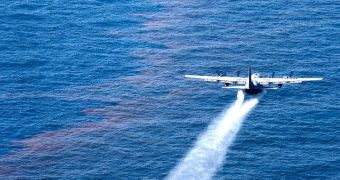Studies conducted on water contaminated with oil last year show that the chemical dispersants used to break apart the material that was ejected from the bottom of the sea lingered in the waters until at least last September
When the Deepwater Horizon semi-submersible oil rig exploded and sunk into the Gulf of Mexico in April 2010, it triggered the worst environmental disaster in US history, which called for vast amounts of dispersants to be spread onto the waters.
The chemicals were used so that they would break the substance apart, and prevent extensive damage to habitats and ecosystems. But the dispersant was supposed to break down into harmless compounds itself, so as to prevent harming marine species itself.
But the recent data indicate that nearly 771,000 gallons (3 million liters) of these hazardous chemicals endured from April to September in Gulf waters, traveling at various locations carried by currents.
These conclusions are based on analysis conducted on water samples collected from areas of interest between May and September 2010. The work was conducted by researchers at the University of California in Santa Barbara (UCSB), who were led by expert David Valentine.
This group carried out periodical sampling campaigns, collecting small volumes of water from plumes that flowed at depths exceeding 1,000 meters. Woods Hole Oceanographic Institution (WHOI) in Massachusetts chemist Elizabeth Kujawinski was in charge of analyzing the samples.
The expert reveals that the dispersants used to mitigate the Gulf spill did not break apart in the waters as they were supposed to. Rather, they moved around in deep plumes of water, until they were diluted in the Atlantic Ocean.
Details of the new research appear in the January 26 online issue of the journal Environmental Science & Technology, Science News reports. The most widely-used dispersant is called Corexit 9500A.
“If the dispersant worked, it should have been associated with the liquid oil – that is, moving off laterally into the deepwater plume,” says Elizabeth Kujawinski.
“Which is where we found it – and the only place. We did not see it below the plume or even sloughing off the top of it,” the chemist adds. Dispersant chemicals were released in the Gulf at rates reaching 13,000 to 80,000 liters per day.
“When you read about Corexit, it’s supposed to biodegrade. [But] Corexit is made up of multiple chemicals, so each might have different biodegradation rates,” adds University of Maryland Center for Environmental Science expert Carys Mitchelmore.

 14 DAY TRIAL //
14 DAY TRIAL //